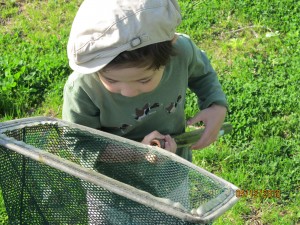 Recording the first time I see various creatures each spring is a habit that stretches back to my childhood, and to this day I keep and even re-read my old notebooks. Over the last few years, the unbridled enthusiasm of a new field partner (not to mention his wonderfully keen eyesight!), has kept me outdoors even more than in the past (see photos).
Recording the first time I see various creatures each spring is a habit that stretches back to my childhood, and to this day I keep and even re-read my old notebooks. Over the last few years, the unbridled enthusiasm of a new field partner (not to mention his wonderfully keen eyesight!), has kept me outdoors even more than in the past (see photos).
Spring 2015 has been slow to arrive and seemingly loathe to take hold here in southern NY and northern NJ. But we have persisted in looking for our favorite spring sights, and over the past several weeks have finally been rewarded with views of old favorites and some new observations as well.
Early Spring Amphibians
There are several vernal ponds in southern Westchester County, NY, where, if the weather and amphibian gods favor us, spotted salamanders, wood frogs and spring peepers can be observed breeding on the same night. As the large, vividly-colored Spotted Salamanders have always been favorites of mine, and are the most elusive of the “Big Three” early spring amphibians, I usually focus on finding them.
 Last year, we hit it just right, and were able to find males beneath leaves along the shore of a breeding pond, awaiting the females’ arrival (the sexes arrive in 2 separate waves, co-mingling only “when necessary”). I’ve found breeding groups as early as March 19th in southern NY, but last year the salamanders showed up during the second week of April. I returned to one favored site during the same week this year, only to find snow on the ground and ice along the pond’s edge! I’ll return soon, hopefully to be rewarded by the sight of their rounded, algae-tinged egg masses.
Last year, we hit it just right, and were able to find males beneath leaves along the shore of a breeding pond, awaiting the females’ arrival (the sexes arrive in 2 separate waves, co-mingling only “when necessary”). I’ve found breeding groups as early as March 19th in southern NY, but last year the salamanders showed up during the second week of April. I returned to one favored site during the same week this year, only to find snow on the ground and ice along the pond’s edge! I’ll return soon, hopefully to be rewarded by the sight of their rounded, algae-tinged egg masses.
An even earlier spring breeder, the Eastern Tiger Salamander (in NY, limited in distribution to eastern Long Island) is sometimes roused to action by mid-February. I was unable to visit any sites this year, but assume they were late in breeding as well, given the frigid February we experienced.
Wood Frogs and Spring Peepers were also weeks later than usual, at least per my records, but have now (May 1) reproduced. A friend called tonight from Cape Cod to say that spring peepers were still in full chorus there.
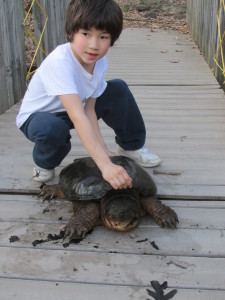 Mid-April in a NJ Swamp: Snappers, Frogs, Birds & Butterflies
Mid-April in a NJ Swamp: Snappers, Frogs, Birds & Butterflies
On April 17, 2015, we visited a small button bush swamp in northern NJ. Last year at this time, it was alive with bullfrogs, painted turtles, aquatic insects and other typical warm weather residents. We almost immediately came upon a large male common snapping turtle, half-buried in the mud in very shallow water. The cool weather rendered him quite sluggish – a plus for the little turtle wrangler who hauled him out for closer inspection! Snappers are about as cold-tolerant as a turtle can be…several years ago I found one basking on February 16th. By mid-April, they are usually their normal feisty selves, ready and willing to do battle…not so this cold, old fellow.
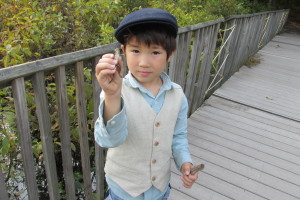 We saw none of the American bullfrogs that normally abound in this swamp, but did net several second-year tadpoles that had emerged from hibernation. Green frogs were also absent from the main swamp, but we flushed several near a small, sun-warmed vernal pond. Our net failed to find any water scorpions, diving beetles or other common aquatic insects, but many over-winter as eggs, and so are difficult to locate prior to maturity.
We saw none of the American bullfrogs that normally abound in this swamp, but did net several second-year tadpoles that had emerged from hibernation. Green frogs were also absent from the main swamp, but we flushed several near a small, sun-warmed vernal pond. Our net failed to find any water scorpions, diving beetles or other common aquatic insects, but many over-winter as eggs, and so are difficult to locate prior to maturity.
Happily, the red-winged blackbirds were out in force, and calling all day. I’ve observed these early harbingers of spring to return to NY as early as February 2nd. A single mourning cloak, one of the few local butterflies that over-winters as an adult, flitted through the still largely-brown woodland that borders the swamp. At 6 PM, a light rain began to fall, and a small chorus of spring peepers, undaunted by daylight, started-up…assuring us, as little else can, that spring was finally here!
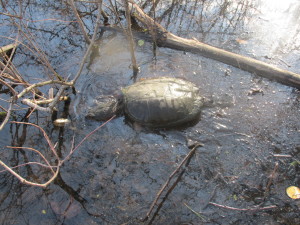 The Great Swamp: Amorous Snappers, Snakes & Beetles
The Great Swamp: Amorous Snappers, Snakes & Beetles
It’s impossible for a naturalist to have a disappointing visit to New Jersey’s magnificent Great Swamp, and our April 24th trip there confirmed this once again. Although perhaps a bit behind schedule, spring was now in full throttle. A pair of snapping turtles mated (or “wrestled”, according to my 7-year-old cohort!) with abandon within 2 feet of a boardwalk (please see photo). The first rainy night in June should bring the female, and almost all others in this part of the country, out to nest.
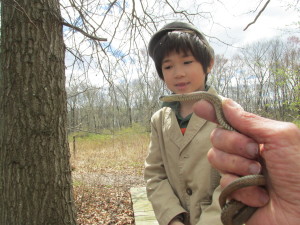 Garter snakes, green frogs and painted turtles were very much in evidence, and flickers issued forth with staccato calls that seemed more suited to a central African rainforest than a NJ suburb. Our prize insect find was a larval caterpillar-hunter beetle. At the nearby Raptor Trust we were treated to several birds we hadn’t seen in some time, including short-eared owls, ravens and, most surprisingly, an albino/leucistic American robin.
Garter snakes, green frogs and painted turtles were very much in evidence, and flickers issued forth with staccato calls that seemed more suited to a central African rainforest than a NJ suburb. Our prize insect find was a larval caterpillar-hunter beetle. At the nearby Raptor Trust we were treated to several birds we hadn’t seen in some time, including short-eared owls, ravens and, most surprisingly, an albino/leucistic American robin.
Along the Hudson: Eels, Eagles & Nesting Herons
When last I searched the southern reaches of the Hudson River, back in late February, bald eagles rode some of the waterway’s many ice floes. Friends who frequent the river’s west shore north of Bear Mountain report that resident eagles are now feeding chicks, great blue herons are brooding eggs, and millions of tiny “glass eels” (juvenile American eels) are on the move.
A late spring means that there’s still time to see some of the wonderful natural events you may have missed, and that we can look forward to the explosion of life that herald’s early summer – get out there if you can, and please post your observations below!
Further Reading
 That Reptile Blog – Reptile, Amphibian and Exotic Pet Care and Information
That Reptile Blog – Reptile, Amphibian and Exotic Pet Care and Information

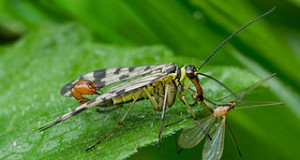

Hi Frank!
My and i have been blessed with two beautiful salimanders that we have found here in northern Indiana. We have been taking care of them for going on three years, and we love them so much. There names are Sammy and Nhym. But we have one large issue…we dont know what kindof salimander they are. Can you help? They are about 6″ long and have 5 toes on the rear legs. They have 11-12 side grooves and the base color is black. They have brown irregular markings all over there bodies including the underbellies. They do not have nasal grooves nore do they have gills. They do have a very shallow groove from the mouth to the hinge of the jaw….if you know what our babies are plese let us know ASAP. thanks
Would you be able to post a picture? That would be most helpful in identifying the species that you have.
-Josh
I would, but i dont know how to post pictures on this sight. Is there any way you could help me out with that?
you could post it to a picture hosting website like photobucket.com and post the link, or email it to me directly at Jmangan@thatpetplace.com